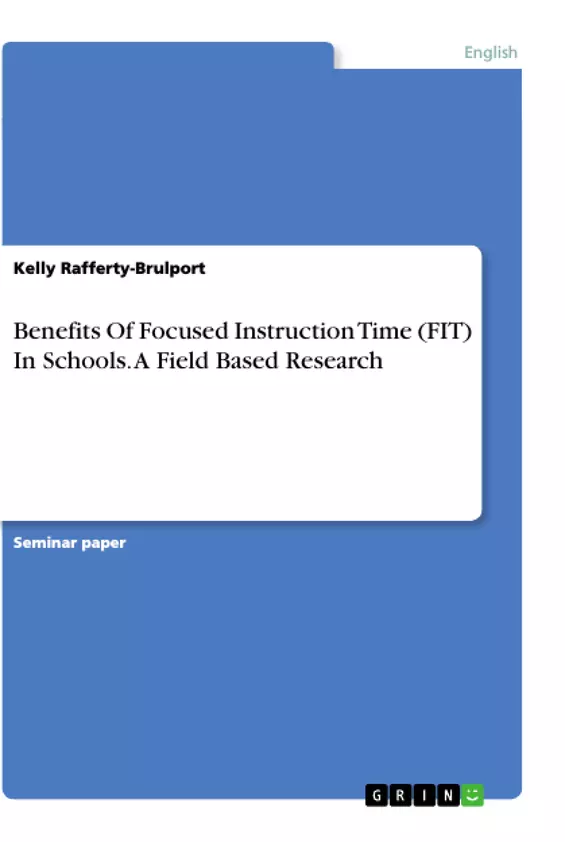The objective of this work investigation is to support the theory that by utilizing focused intervention time with a target and control group of students, students in fifth grade can achieve higher scores overall (on vocabulary and comprehension assessments) by targeting specific student needs with regards to fluency and comprehension. Focused Instructional Time is a fifty-minute block that occurs for students at the South Shore Charter Public School Tuesday through Friday each week. To address fluency and reading comprehension deficits, this researcher completed targeted interventions to address individual student needs in the form of a Book Club, throughout a twelve-week period.
This topic is important to research because the focused instructional model is a research-based approach to learning. This is an opportunity every day for students to have additional service delivery if their IEP needs require individual and/or small group service delivery, in addition to the push in, co-taught model that SSCPS embodies. This Focused Instructional Time can benefit not only students who have specific plans, but teachers can utilize the time to meet each student’s individual needs, including higher achieving students who wish to be challenged and extend upon topics taught in their regular education classrooms.
After meetings with different administrators to understand their perspective on defining "focused instructional time," this researcher also met with teachers to gather their thoughts on the topic, and how they feel it should be utilized day to day. It is imperative that all adults in the school have the same drive and understanding of the expectations for that time with students to be successful. This researcher gathered, at random, ten students in fifth grade to be part of the target group for interventions, thinking that all students can increase their fluency and comprehension, regardless of instructional and independent reading levels.
Inhaltsverzeichnis (Table of Contents)
- Abstract
- Introduction
- Background
- Literature Review
- Methodology
- Results
- Discussion
- Conclusion
- References
Zielsetzung und Themenschwerpunkte (Objectives and Key Themes)
This research project investigates the effectiveness of Focused Instructional Time (FIT) in improving reading comprehension among fifth-grade students. The study aims to provide evidence for the hypothesis that targeted interventions during FIT can positively impact student scores on vocabulary and comprehension assessments.
- The impact of Focused Instructional Time on student reading comprehension
- The role of targeted interventions in addressing individual student needs
- The importance of differentiated instruction and scaffolding in supporting student learning
- The challenges of identifying and supporting English Language Learners (ELLs) in the classroom
- The need for effective assessment tools to measure student growth and comprehension
Zusammenfassung der Kapitel (Chapter Summaries)
- Abstract: This chapter provides a brief overview of the research project, outlining the problem, the objectives, and the research methodology. It also emphasizes the importance of focused instructional time as a research-based approach to learning.
- Introduction: This chapter delves into the context of the research, highlighting the challenges faced by teachers in assessing student comprehension. It explores the need for effective interventions to address individual student needs and improve reading skills.
- Background: This chapter examines the theoretical framework of the study, emphasizing the importance of differentiated instruction and scaffolding to meet the diverse needs of students. It introduces the concept of Structured English Immersion (SEI) strategies and their potential for enhancing comprehension and fluency.
- Literature Review: This chapter explores existing research on reading comprehension, highlighting the complex cognitive processes involved and the challenges associated with supporting diverse learners. It discusses the difficulties in identifying and supporting ELLs, particularly in the context of reading difficulties.
- Methodology: This chapter details the research design and methods used to collect and analyze data. It explains the selection of participants, the intervention strategies employed, and the assessment tools used to measure student progress.
- Results: This chapter presents the findings of the study, outlining the quantitative and qualitative data collected and analyzed. It examines the impact of the intervention on student scores and provides evidence to support or refute the study's hypothesis.
- Discussion: This chapter interprets the results of the study, drawing conclusions about the effectiveness of focused instructional time and the implications for educational practice. It discusses the limitations of the study and suggests areas for future research.
Schlüsselwörter (Keywords)
The key concepts explored in this research include focused instructional time, reading comprehension, fluency, differentiated instruction, scaffolding, English Language Learners (ELLs), Structured English Immersion (SEI) strategies, and assessment.
- Quote paper
- Kelly Rafferty-Brulport (Author), 2020, Benefits Of Focused Instruction Time (FIT) In Schools. A Field Based Research, Munich, GRIN Verlag, https://www.hausarbeiten.de/document/583902


